2014 NISSAN LEAF sensor
[x] Cancel search: sensorPage 312 of 397
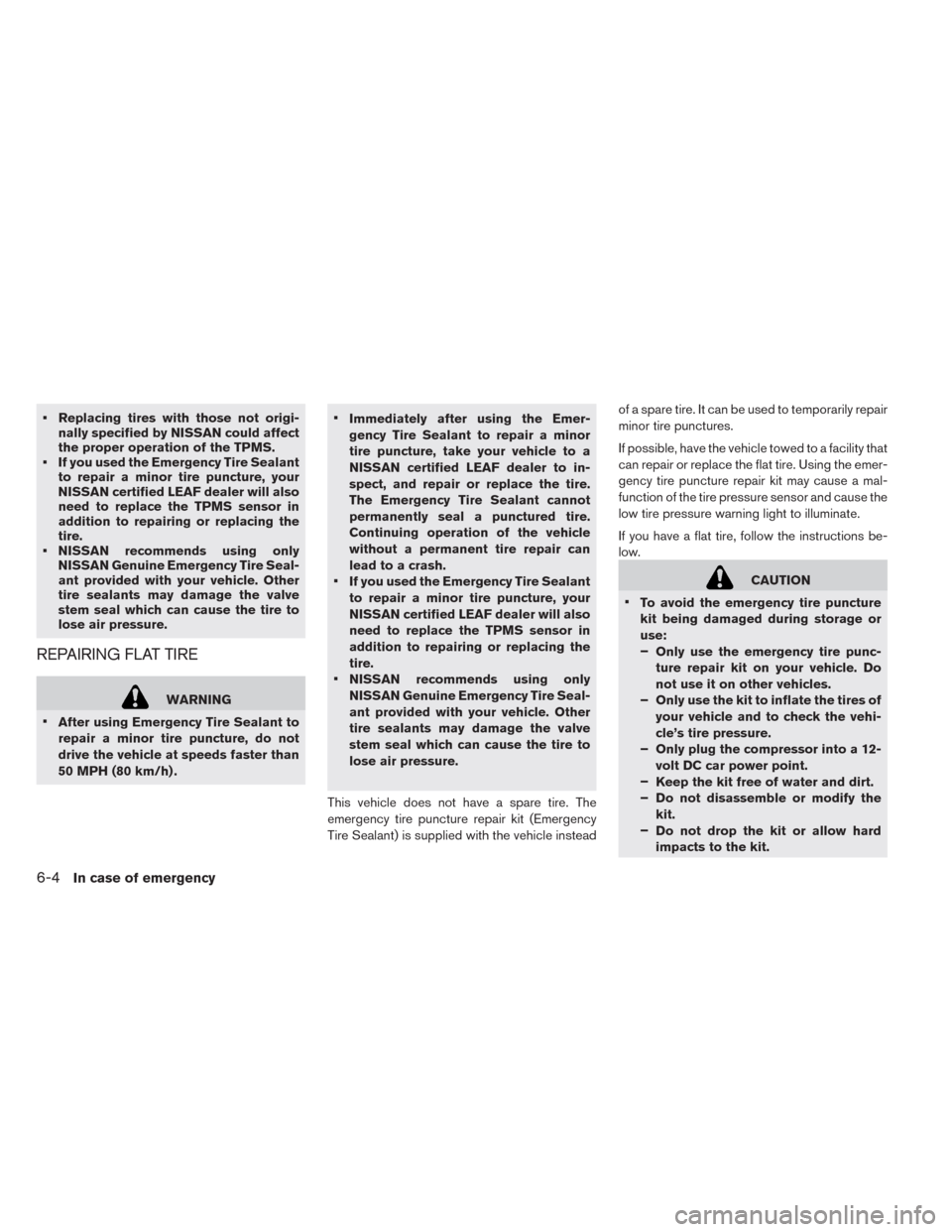
• Replacing tires with those not origi-
nally specified by NISSAN could affect
the proper operation of the TPMS.
• If you used the Emergency Tire Sealant
to repair a minor tire puncture, your
NISSAN certified LEAF dealer will also
need to replace the TPMS sensor in
addition to repairing or replacing the
tire.
• NISSAN recommends using only
NISSAN Genuine Emergency Tire Seal-
ant provided with your vehicle. Other
tire sealants may damage the valve
stem seal which can cause the tire to
lose air pressure.
REPAIRING FLAT TIRE
WARNING
•
After using Emergency Tire Sealant to
repair a minor tire puncture, do not
drive the vehicle at speeds faster than
50 MPH (80 km/h) .•
Immediately after using the Emer-
gency Tire Sealant to repair a minor
tire puncture, take your vehicle to a
NISSAN certified LEAF dealer to in-
spect, and repair or replace the tire.
The Emergency Tire Sealant cannot
permanently seal a punctured tire.
Continuing operation of the vehicle
without a permanent tire repair can
lead to a crash.
•
If you used the Emergency Tire Sealant
to repair a minor tire puncture, your
NISSAN certified LEAF dealer will also
need to replace the TPMS sensor in
addition to repairing or replacing the
tire.
•
NISSAN recommends using only
NISSAN Genuine Emergency Tire Seal-
ant provided with your vehicle. Other
tire sealants may damage the valve
stem seal which can cause the tire to
lose air pressure.
This vehicle does not have a spare tire. The
emergency tire puncture repair kit (Emergency
Tire Sealant) is supplied with the vehicle insteadof a spare tire. It can be used to temporarily repair
minor tire punctures.
If possible, have the vehicle towed to a facility that
can repair or replace the flat tire. Using the emer-
gency tire puncture repair kit may cause a mal-
function of the tire pressure sensor and cause the
low tire pressure warning light to illuminate.
If you have a flat tire, follow the instructions be-
low.
CAUTION
•
To avoid the emergency tire puncture
kit being damaged during storage or
use:
–
Only use the emergency tire punc-
ture repair kit on your vehicle. Do
not use it on other vehicles.
–
Only use the kit to inflate the tires of
your vehicle and to check the vehi-
cle’s tire pressure.
–
Only plug the compressor into a 12-
volt DC car power point.
–
Keep the kit free of water and dirt.
–
Do not disassemble or modify the
kit.
–
Do not drop the kit or allow hard
impacts to the kit.
6-4In case of emergency
Page 314 of 397
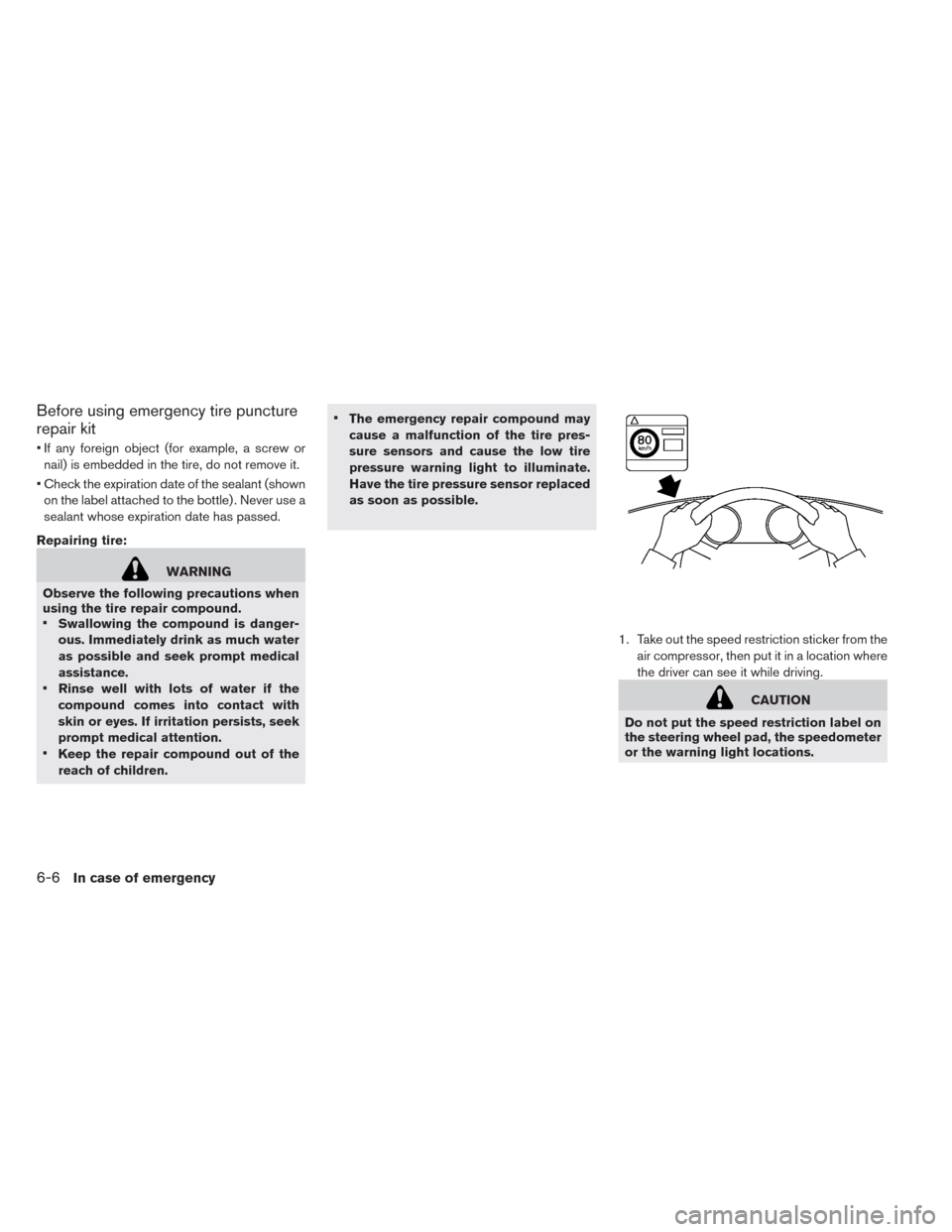
Before using emergency tire puncture
repair kit
• If any foreign object (for example, a screw or
nail) is embedded in the tire, do not remove it.
• Check the expiration date of the sealant (shown
on the label attached to the bottle) . Never use a
sealant whose expiration date has passed.
Repairing tire:
WARNING
Observe the following precautions when
using the tire repair compound.
•
Swallowing the compound is danger-
ous. Immediately drink as much water
as possible and seek prompt medical
assistance.
•
Rinse well with lots of water if the
compound comes into contact with
skin or eyes. If irritation persists, seek
prompt medical attention.
•
Keep the repair compound out of the
reach of children.•
The emergency repair compound may
cause a malfunction of the tire pres-
sure sensors and cause the low tire
pressure warning light to illuminate.
Have the tire pressure sensor replaced
as soon as possible.
1. Take out the speed restriction sticker from the
air compressor, then put it in a location where
the driver can see it while driving.
CAUTION
Do not put the speed restriction label on
the steering wheel pad, the speedometer
or the warning light locations.
6-6In case of emergency
Page 317 of 397
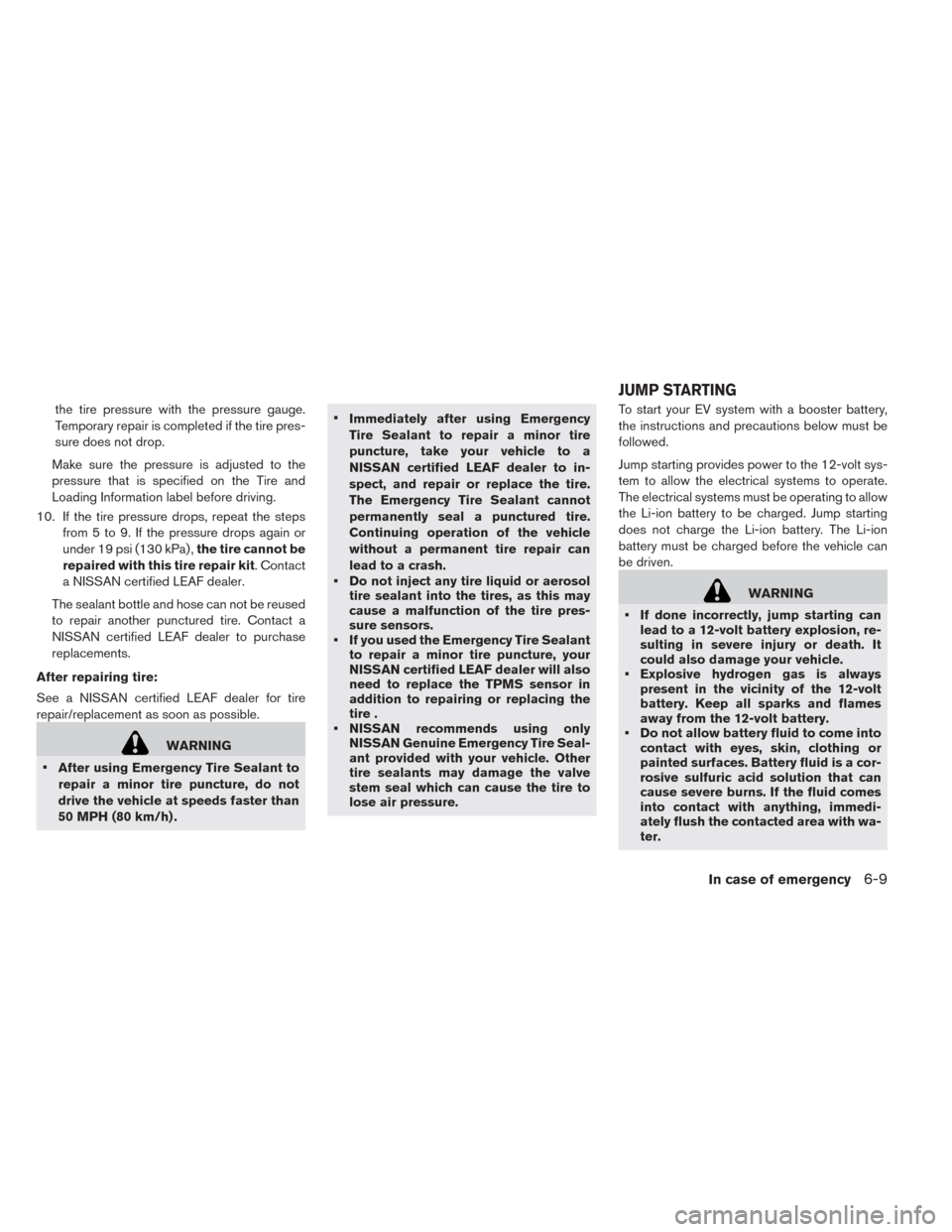
the tire pressure with the pressure gauge.
Temporary repair is completed if the tire pres-
sure does not drop.
Make sure the pressure is adjusted to the
pressure that is specified on the Tire and
Loading Information label before driving.
10. If the tire pressure drops, repeat the steps
from 5 to 9. If the pressure drops again or
under 19 psi (130 kPa) ,the tire cannot be
repaired with this tire repair kit. Contact
a NISSAN certified LEAF dealer.
The sealant bottle and hose can not be reused
to repair another punctured tire. Contact a
NISSAN certified LEAF dealer to purchase
replacements.
After repairing tire:
See a NISSAN certified LEAF dealer for tire
repair/replacement as soon as possible.
WARNING
•
After using Emergency Tire Sealant to
repair a minor tire puncture, do not
drive the vehicle at speeds faster than
50 MPH (80 km/h) .•
Immediately after using Emergency
Tire Sealant to repair a minor tire
puncture, take your vehicle to a
NISSAN certified LEAF dealer to in-
spect, and repair or replace the tire.
The Emergency Tire Sealant cannot
permanently seal a punctured tire.
Continuing operation of the vehicle
without a permanent tire repair can
lead to a crash.
• Do not inject any tire liquid or aerosol
tire sealant into the tires, as this may
cause a malfunction of the tire pres-
sure sensors.
• If you used the Emergency Tire Sealant
to repair a minor tire puncture, your
NISSAN certified LEAF dealer will also
need to replace the TPMS sensor in
addition to repairing or replacing the
tire .
• NISSAN recommends using only
NISSAN Genuine Emergency Tire Seal-
ant provided with your vehicle. Other
tire sealants may damage the valve
stem seal which can cause the tire to
lose air pressure.To start your EV system with a booster battery,
the instructions and precautions below must be
followed.
Jump starting provides power to the 12-volt sys-
tem to allow the electrical systems to operate.
The electrical systems must be operating to allow
the Li-ion battery to be charged. Jump starting
does not charge the Li-ion battery. The Li-ion
battery must be charged before the vehicle can
be driven.
WARNING
• If done incorrectly, jump starting can
lead to a 12-volt battery explosion, re-
sulting in severe injury or death. It
could also damage your vehicle.
• Explosive hydrogen gas is always
present in the vicinity of the 12-volt
battery. Keep all sparks and flames
away from the 12-volt battery.
• Do not allow battery fluid to come into
contact with eyes, skin, clothing or
painted surfaces. Battery fluid is a cor-
rosive sulfuric acid solution that can
cause severe burns. If the fluid comes
into contact with anything, immedi-
ately flush the contacted area with wa-
ter.
JUMP STARTING
In case of emergency6-9
Page 328 of 397
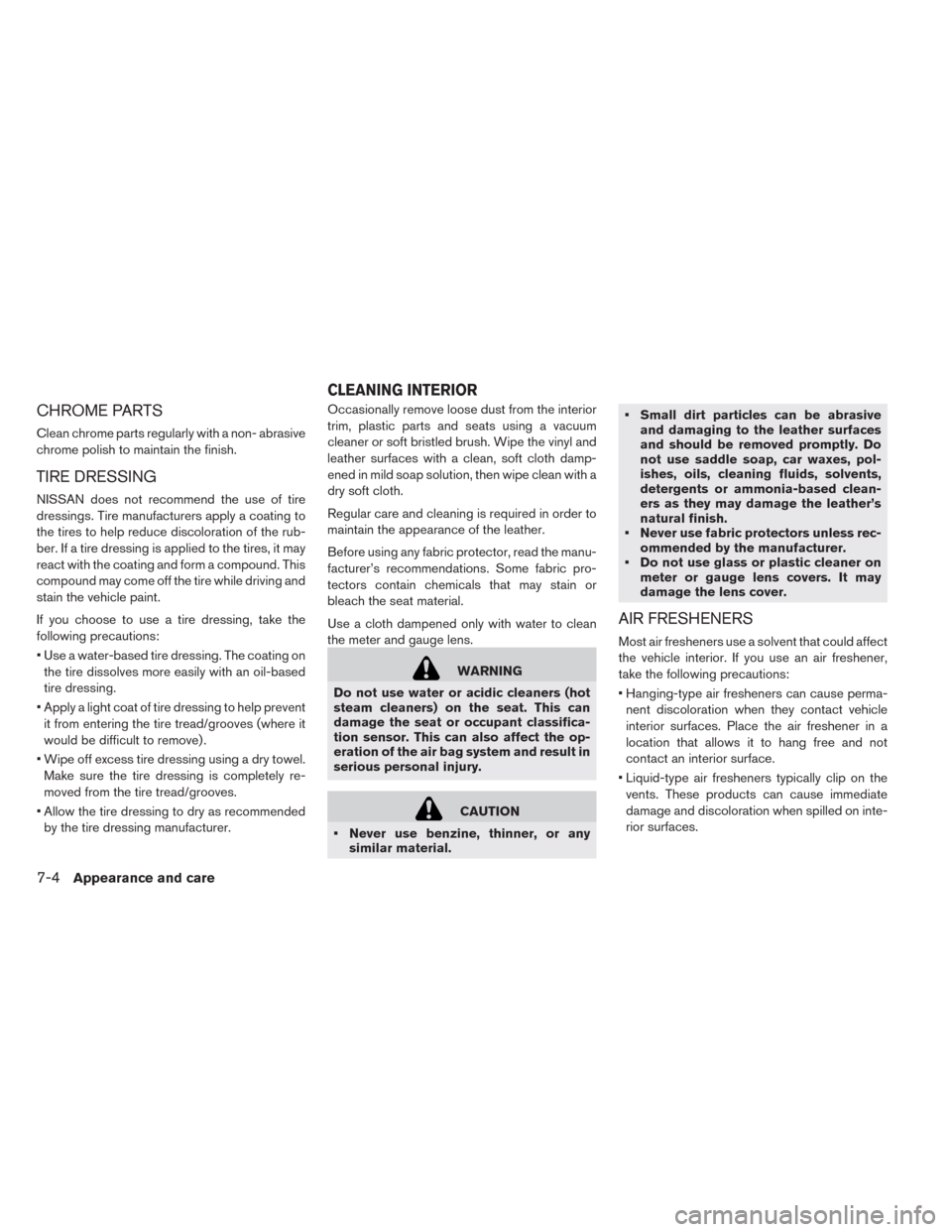
CHROME PARTS
Clean chrome parts regularly with a non- abrasive
chrome polish to maintain the finish.
TIRE DRESSING
NISSAN does not recommend the use of tire
dressings. Tire manufacturers apply a coating to
the tires to help reduce discoloration of the rub-
ber. If a tire dressing is applied to the tires, it may
react with the coating and form a compound. This
compound may come off the tire while driving and
stain the vehicle paint.
If you choose to use a tire dressing, take the
following precautions:
• Use a water-based tire dressing. The coating on
the tire dissolves more easily with an oil-based
tire dressing.
• Apply a light coat of tire dressing to help prevent
it from entering the tire tread/grooves (where it
would be difficult to remove) .
• Wipe off excess tire dressing using a dry towel.
Make sure the tire dressing is completely re-
moved from the tire tread/grooves.
• Allow the tire dressing to dry as recommended
by the tire dressing manufacturer.Occasionally remove loose dust from the interior
trim, plastic parts and seats using a vacuum
cleaner or soft bristled brush. Wipe the vinyl and
leather surfaces with a clean, soft cloth damp-
ened in mild soap solution, then wipe clean with a
dry soft cloth.
Regular care and cleaning is required in order to
maintain the appearance of the leather.
Before using any fabric protector, read the manu-
facturer’s recommendations. Some fabric pro-
tectors contain chemicals that may stain or
bleach the seat material.
Use a cloth dampened only with water to clean
the meter and gauge lens.
WARNING
Do not use water or acidic cleaners (hot
steam cleaners) on the seat. This can
damage the seat or occupant classifica-
tion sensor. This can also affect the op-
eration of the air bag system and result in
serious personal injury.
CAUTION
• Never use benzine, thinner, or any
similar material.• Small dirt particles can be abrasive
and damaging to the leather surfaces
and should be removed promptly. Do
not use saddle soap, car waxes, pol-
ishes, oils, cleaning fluids, solvents,
detergents or ammonia-based clean-
ers as they may damage the leather’s
natural finish.
• Never use fabric protectors unless rec-
ommended by the manufacturer.
• Do not use glass or plastic cleaner on
meter or gauge lens covers. It may
damage the lens cover.
AIR FRESHENERS
Most air fresheners use a solvent that could affect
the vehicle interior. If you use an air freshener,
take the following precautions:
• Hanging-type air fresheners can cause perma-
nent discoloration when they contact vehicle
interior surfaces. Place the air freshener in a
location that allows it to hang free and not
contact an interior surface.
• Liquid-type air fresheners typically clip on the
vents. These products can cause immediate
damage and discoloration when spilled on inte-
rior surfaces.
CLEANING INTERIOR
7-4Appearance and care
Page 366 of 397
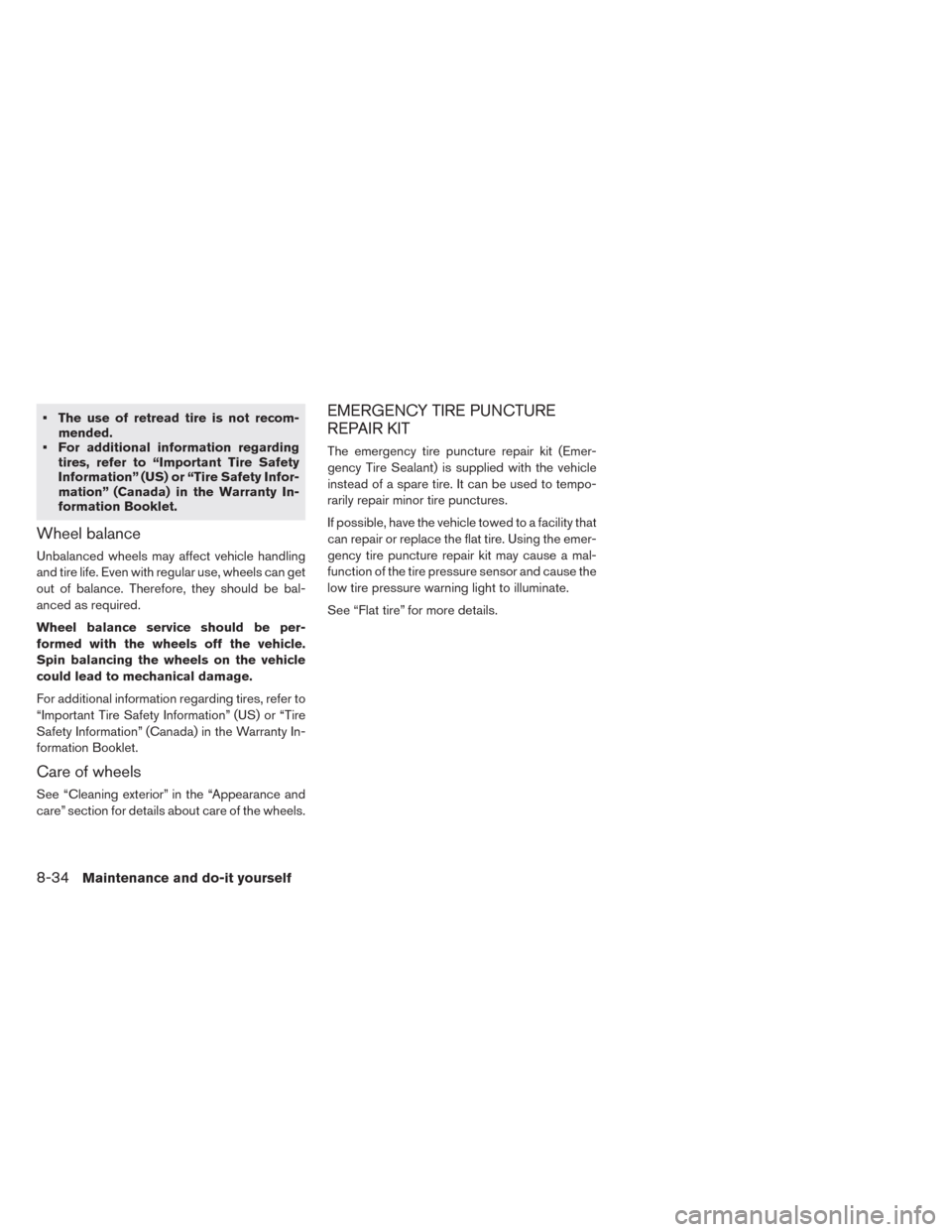
• The use of retread tire is not recom-
mended.
• For additional information regarding
tires, refer to “Important Tire Safety
Information” (US) or “Tire Safety Infor-
mation” (Canada) in the Warranty In-
formation Booklet.
Wheel balance
Unbalanced wheels may affect vehicle handling
and tire life. Even with regular use, wheels can get
out of balance. Therefore, they should be bal-
anced as required.
Wheel balance service should be per-
formed with the wheels off the vehicle.
Spin balancing the wheels on the vehicle
could lead to mechanical damage.
For additional information regarding tires, refer to
“Important Tire Safety Information” (US) or “Tire
Safety Information” (Canada) in the Warranty In-
formation Booklet.
Care of wheels
See “Cleaning exterior” in the “Appearance and
care” section for details about care of the wheels.
EMERGENCY TIRE PUNCTURE
REPAIR KIT
The emergency tire puncture repair kit (Emer-
gency Tire Sealant) is supplied with the vehicle
instead of a spare tire. It can be used to tempo-
rarily repair minor tire punctures.
If possible, have the vehicle towed to a facility that
can repair or replace the flat tire. Using the emer-
gency tire puncture repair kit may cause a mal-
function of the tire pressure sensor and cause the
low tire pressure warning light to illuminate.
See “Flat tire” for more details.
8-34Maintenance and do-it yourself